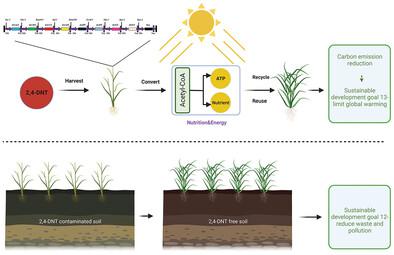Our official English website, www.x-mol.net, welcomes your
feedback! (Note: you will need to create a separate account there.)
Creation of Environmentally Friendly Super “Dinitrotoluene Scavenger” Plants
Advanced Science ( IF 14.3 ) Pub Date : 2023-09-15 , DOI: 10.1002/advs.202303785 Jian-Jie Gao 1, 2, 3 , Zhen-Jun Li 1, 2, 3 , Bo Zhu 4 , Li-Juan Wang 1, 2, 3 , Jing Xu 1, 2, 3 , Bo Wang 1, 2, 3 , Xiao-Yan Fu 1, 2, 3 , Hong-Juan Han 1, 2, 3 , Wen-Hui Zhang 1, 2, 3 , Yong-Dong Deng 1, 2, 3 , Yu Wang 1, 2, 3 , Zhi-Hao Zuo 1, 2, 3 , Ri-He Peng 1, 2, 3 , Yong-Sheng Tian 1, 2, 3 , Quan-Hong Yao 1, 2, 3
Advanced Science ( IF 14.3 ) Pub Date : 2023-09-15 , DOI: 10.1002/advs.202303785 Jian-Jie Gao 1, 2, 3 , Zhen-Jun Li 1, 2, 3 , Bo Zhu 4 , Li-Juan Wang 1, 2, 3 , Jing Xu 1, 2, 3 , Bo Wang 1, 2, 3 , Xiao-Yan Fu 1, 2, 3 , Hong-Juan Han 1, 2, 3 , Wen-Hui Zhang 1, 2, 3 , Yong-Dong Deng 1, 2, 3 , Yu Wang 1, 2, 3 , Zhi-Hao Zuo 1, 2, 3 , Ri-He Peng 1, 2, 3 , Yong-Sheng Tian 1, 2, 3 , Quan-Hong Yao 1, 2, 3
Affiliation

|
Pervasive environmental contamination due to the uncontrolled dispersal of 2,4-dinitrotoluene (2,4-DNT) represents a substantial global health risk, demanding urgent intervention for the removal of this detrimental compound from affected sites and the promotion of ecological restoration. Conventional methodologies, however, are energy-intensive, susceptible to secondary pollution, and may inadvertently increase carbon emissions. In this study, a 2,4-DNT degradation module is designed, assembled, and validated in rice plants. Consequently, the modified rice plants acquire the ability to counteract the phytotoxicity of 2,4-DNT. The most significant finding of this study is that these modified rice plants can completely degrade 2,4-DNT into innocuous substances and subsequently introduce them into the tricarboxylic acid cycle. Further, research reveals that the modified rice plants enable the rapid phytoremediation of 2,4-DNT-contaminated soil. This innovative, eco-friendly phytoremediation approach for dinitrotoluene-contaminated soil and water demonstrates significant potential across diverse regions, substantially contributing to carbon neutrality and sustainable development objectives by repurposing carbon and energy from organic contaminants.
中文翻译:

创建环保超级“二硝基甲苯清除剂”工厂
由于 2,4-二硝基甲苯 (2,4-DNT) 不受控制的扩散造成的普遍环境污染对全球健康构成了重大风险,需要采取紧急干预措施,从受影响地点清除这种有害化合物并促进生态恢复。然而,传统的方法是能源密集型的,容易受到二次污染,并且可能无意中增加碳排放。在这项研究中,设计、组装了 2,4-DNT 降解模块,并在水稻中进行了验证。因此,修饰的水稻植物获得了抵消2,4-DNT植物毒性的能力。这项研究最重要的发现是这些转基因水稻植物可以将2,4-DNT完全降解为无毒物质,然后将其引入三羧酸循环。此外,研究表明,改良水稻植物能够快速植物修复 2,4-DNT 污染的土壤。这种针对二硝基甲苯污染的土壤和水的创新、环保的植物修复方法在不同地区表现出巨大的潜力,通过重新利用有机污染物中的碳和能量,为碳中和和可持续发展目标做出了重大贡献。
更新日期:2023-09-15
中文翻译:

创建环保超级“二硝基甲苯清除剂”工厂
由于 2,4-二硝基甲苯 (2,4-DNT) 不受控制的扩散造成的普遍环境污染对全球健康构成了重大风险,需要采取紧急干预措施,从受影响地点清除这种有害化合物并促进生态恢复。然而,传统的方法是能源密集型的,容易受到二次污染,并且可能无意中增加碳排放。在这项研究中,设计、组装了 2,4-DNT 降解模块,并在水稻中进行了验证。因此,修饰的水稻植物获得了抵消2,4-DNT植物毒性的能力。这项研究最重要的发现是这些转基因水稻植物可以将2,4-DNT完全降解为无毒物质,然后将其引入三羧酸循环。此外,研究表明,改良水稻植物能够快速植物修复 2,4-DNT 污染的土壤。这种针对二硝基甲苯污染的土壤和水的创新、环保的植物修复方法在不同地区表现出巨大的潜力,通过重新利用有机污染物中的碳和能量,为碳中和和可持续发展目标做出了重大贡献。













































 京公网安备 11010802027423号
京公网安备 11010802027423号